Massachusetts Rental Lease Agreement Templates
The Massachusetts Rental Lease Agreements are documents used for establishing a legal bond between lessees and a lessor (the landlord) over the renting of vacant property. In Massachusetts, any lease lasting longer than twelve (12) months requires a written agreement.
Overall, the documents are used for ensuring the parties understand their obligations to one another, which are partly mandated by MA lease law. Although conditions may vary from contract to contract, they all relate in the sense that they set out to establish the lease term, parties to the agreement, and the rules and expectations of the lessor and lessee(s).
Types (6)
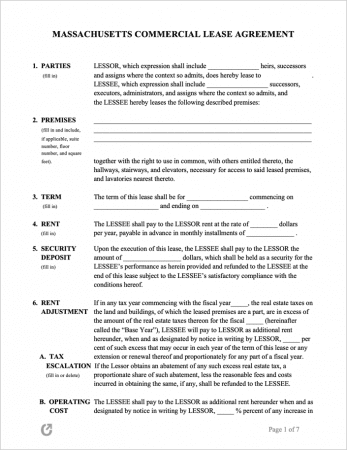 Commercial Lease Agreement – A lease agreement that establishes the legal relationship between a landlord that owns or manages commercial property, and a business owner looking to run their company out of it.
Commercial Lease Agreement – A lease agreement that establishes the legal relationship between a landlord that owns or manages commercial property, and a business owner looking to run their company out of it.
Download – Adobe PDF (.pdf) | Word (.docx) | Rich Text (.rtf)
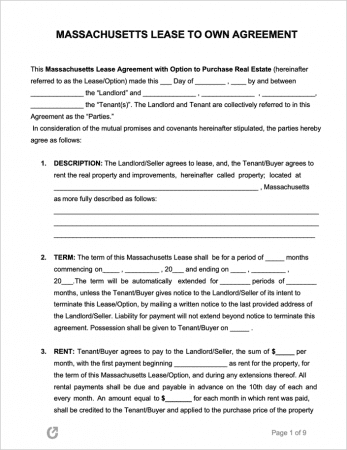 Lease to Own Agreement – Also referred to as a “Rent to Own Agreement”, this agreement allows tenants to use the rent they pay as a down payment for the rental property to be purchased at a later date.
Lease to Own Agreement – Also referred to as a “Rent to Own Agreement”, this agreement allows tenants to use the rent they pay as a down payment for the rental property to be purchased at a later date.
Download – Adobe PDF (.pdf) | Word (.docx) | Rich Text (.rtf)
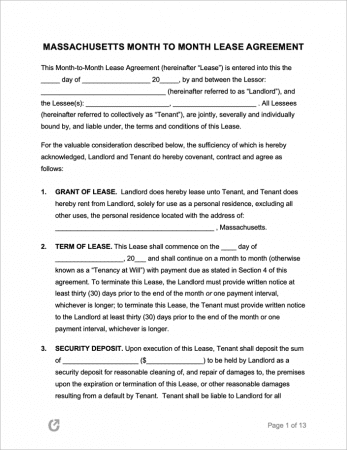 Month-to-Month Rental Agreement – This contract offers greater flexibility than a fixed-term lease by outlining conditions for a rental unit to be rented on a month-to-month basis.
Month-to-Month Rental Agreement – This contract offers greater flexibility than a fixed-term lease by outlining conditions for a rental unit to be rented on a month-to-month basis.
Download – Adobe PDF (.pdf) | Word (.docx) | Rich Text (.rtf)
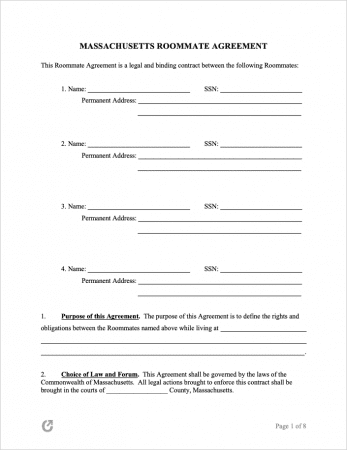 Roommate Agreement – In contrast to a lease agreement, the document is only created and signed by roommates wanting to clarify matters pertaining to their shared residence in a rental unit. Allows tenants to set rules on cleaning, utilities, guests, and other topics.
Roommate Agreement – In contrast to a lease agreement, the document is only created and signed by roommates wanting to clarify matters pertaining to their shared residence in a rental unit. Allows tenants to set rules on cleaning, utilities, guests, and other topics.
Download – Adobe PDF (.pdf) | Word (.docx) | Rich Text (.rtf)
 Standard Residential Lease Agreement (Form 401) – The official form provided by the Mass Real Estate Association for the renting of a residential dwelling in the state. Created in accordance with Ch. 186 of the MA general laws.
Standard Residential Lease Agreement (Form 401) – The official form provided by the Mass Real Estate Association for the renting of a residential dwelling in the state. Created in accordance with Ch. 186 of the MA general laws.
Download – Adobe PDF (.pdf)
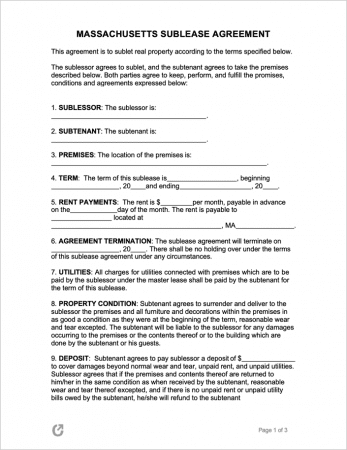 Sublease Agreement – An agreement that provides the legal structure (in a similar fashion to a standard lease) for a tenant to lease their currently-rented space to another tenant.
Sublease Agreement – An agreement that provides the legal structure (in a similar fashion to a standard lease) for a tenant to lease their currently-rented space to another tenant.
Download – Adobe PDF (.pdf) | Word (.docx)
What is a Massachusetts Lease Agreement?
A Massachusetts lease agreement can be thought of as the legal “glue” binding a landlord and a tenant into a relationship with one another surrounding the leasing of a commercial or residential property. The form makes it so a tenant cannot simply “leave” a rental property after agreeing to rent it, providing the landlord with security for the duration of the lease. The agreement requires each party to meet a number of legal expectations that are specified in the rental contract, such as paying for utilities, keeping noise levels within reason, keeping the rental in good shape, and other subjects. Landlords who want to conduct a tenant screening before selecting a suitable tenant should ensure they make use of a rental application form, which asks a tenant several questions regarding their past rental experiences and provides the landlord with detailed information on their credit and criminal history.
State Laws & Guides
Laws: 940 CMR 3.00
Residential Leasing Guides
Commercial Leasing Guide
When is Rent Due?
There is no statute in state law that dictates when rent is due. Landlords should, therefore, make their preferences regarding the matter clear in the lease agreement. In line with Chapter 186, Section 15B(c), landlords are required to wait for a minimum of thirty (30) days after the date in which rent is due before they can issue a late fee to the tenant(s).
Landlord’s Access
Emergency (Landlord-Tenant Guide – Pg. 5): Landlords have the right to enter rental properties without notice in the event of an emergency that has the chance of damaging the entire building or other units.
Non-Emergency (MGL c.186 § 15B(1)(a)): Rental agreements may not grant landlords unlimited access to the rental unit. However, they may enter in a limited set of circumstances, including to inspect the premises and make repairs. There is no required amount of notice that needs to be given, but in the interests of maintaining a good landlord-tenant relationship, landlords should give tenants at least twenty-four (24) hours notice, and only enter during reasonable times (on business days from 9 a.m. to 6 p.m, for example).
Required Disclosures
- Fire Insurance (Chapter 186, § 21): Upon written request by the tenant, landlords must disclose in writing within fifteen (15) days: the name of the entity providing insurance in the event of loss or damage to the rental by fire. Additionally, the amount of insurance that would be paid out in such circumstances and the person(s) who would receive payment from the insurance must be disclosed.
- Lead Paint Disclosure: Landlords are Federally required to disclose if their rental property was built before 1978 and has any known lead paint hazards. In such cases, they must provide the tenant(s) with the government-created EPA pamphlet.
- Security Deposit Bank Details (Chapter 186, Section 15B): Landlords who demand a security deposit must, within thirty (30) days of receiving it, provide tenants with a receipt that indicates the name and location of the bank in which the security deposit has been deposited, as well as the amount and account number of the deposit.
- Security Deposit Statement (Chapter 186, Section 15B(2)(c)): Upon receipt of a security deposit or within ten (10) days after the start of the tenancy, whichever is later, landlords are required to provide tenants with a written statement describing the present condition of the rental. It should also contain a comprehensive list of any pre-existing damage in the premises, including, but not limited to any violations of the sanitary or state building codes (as certified by a local health board or building official officially declared by a court). The tenant then has fifteen (15) days to make any additions to the statement. The statement must be signed and contain a specific notice that can be found in Ch. 186, Section 15B, which is:
”This is a statement of the condition of the premises you have leased or rented. You should read it carefully in order to see if it is correct. If it is correct you must sign it. This will show that you agree that the list is correct and complete. If it is not correct, you must attach a separate signed list of any damage which you believe exists in the premises. This statement must be returned to the lessor or his agent within fifteen days after you receive this list or within fifteen days after you move in, whichever is later. If you do not return this list, within the specified time period, a court may later view your failure to return the list as your agreement that the list is complete and correct in any suit which you may bring to recover the security deposit.” – Chapter 186, Section 15B(2)(c)
Security Deposits
Maximum (Chapter 186, Section 15B): Security deposits are capped at an equivalent amount to one (1) month’s rent.
Massachusetts Bank: Landlords must collect the security deposit in the first (1st) month of the tenancy. Furthermore, the security deposit must be deposited in a Massachusetts bank of the landlord’s choosing.
Returning to Tenant (Chapter 186, Section 15B): Landlords must return a security deposit to tenants within thirty (30) days after the tenants have vacated the rental. In addition to the deposit, any interest accumulated on the deposit must also be paid out for leases longer than one (1) year at the termination of the tenancy. Inline state law, landlords must pay five percent (5%) interest, or the lesser amount of interest received from the bank where the deposit has been held.
